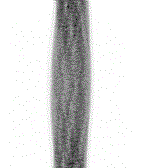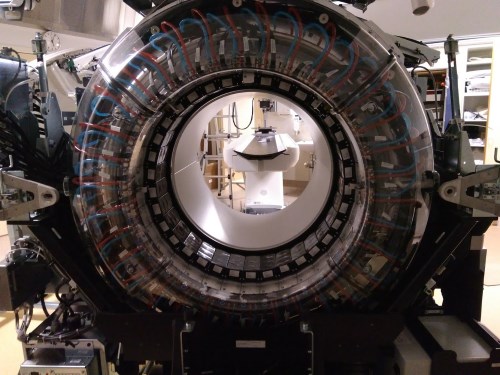PET raw data
The raw data collected during PET scanning is processed by the scanner computing unit and stored as sinogram file, containing the count averages during each predefined time frame. New scanners can save the data as list mode data (without predefined time frames), from which the sinogram can be calculated. Sinogram data is then reconstructed to PET image.
Please see the PET Basics presentations for more information on the PET instrumentation and image reconstruction methods.


Figure 1. Examples one plane of a 2D sinogram (left) scanned with GE Advance, and the corresponding PET image (right) reconstructed from it.
Scanners and file formats
PET-CT and PET-MR scanners store the raw data in proprietary formats which can be processed only by the software provided by the scanner manufacturer.
ECAT HR+ produced ECAT 7.x format sinogram files (format is defined e.g. in ECAT Software Operating Instructions Version 7.2). ECAT 931, which was put out of operation in the end of April 2005, saved raw data in ECAT 6.3 format. ECAT 6.3 format for sinograms, normalization and attenuation files is defined in Siemens manual (Operating Instructions ECAT Scanner Software). To reconstruct the ECAT sinograms (*.scn) to images, also the attenuation (*.atn) and normalization (*.nrm) files are required!
2D raw data from GE Advance were automatically converted to CTI ECAT 6.3 format. 3D raw data from GE Advance can be read from the GE database (contact physicists), but this data cannot be used by in-house software. The GE Advance sinograms in ECAT format are already attenuation and normalization corrected, thus separate files for these purposes are not needed.
HRRT, which was put out of operation in May 2023, produced sinograms in Interfile format
(Todd-Pokropek et al., 1992).
If necessary, these can be converted to ECAT 7 format using if2ecat program
(PC/Windows XP) provided by the scanner manufacturer.
Angular compression
Angular compression is a technique used to reduce the amount of data in a sinogram. When angular compression is applied, data in the sinogram are summed in the angular direction. This technique has been shown to have little effect near the centre of the field of view (FOV). However, it could cause loss of precision. You can apply angular compression when the sinogram is acquired, and/or when it is reconstructed.
In-house software for processing ECAT format sinograms
Sinogram data in ECAT formats can be processed using the following in-house programs:
- Normalization, and optionally attenuation correction, of ECAT 931 sinogram: ecatnorm
- Reconstruct image from ECAT 931 sinogram: ecatfbp and ecatmrp
- Extracting line-of-response: lor2dft
- Making a grey-scale or rainbow color-scale TIFF image file for insertion into PowerPoint etc: img2tif
- Simple arithmetic calculation for ECAT sinogram and image files: imgcalc
- Combining two or more ECAT sinogram or image files: ecatcat
- Turning images or sinograms horizontally and/or vertically: imgflip
- Produce a "head curve", i.e. an average of all pixels as a function of time: imghead
- Using a look-up table to replace the pixel values in sinogram or image: imglkup
- Sorting matrices in ascending order: ctisort
- Extracting specified planes and frames to a new file: esplit
- Sum together the specified frames from a dynamic sinogram to emulate static scan: ecatssum
- Correction of the late scan frame times relative to the injection time, when scanning was started later: ecattime
- Setting ECAT sinogram and image frame times: eframe
- Setting ECAT 6.3 sinogram and image frame times and scan start time from SIF: sif2ecat
- Set sinogram values outside specified transaxial FOV to zero: scnfovrm.
- Tools for calculation of scatter fraction: scnmshft and scatterf.
- Editing ECAT 7 main header: e7emhdr and 3D scan subheader: e7eshdr.html
- Removing patient name from ECAT 6.3 and 7 files: ecatanon
- Listing segments and sinograms in 3D scan file: e7lsegm
- Extracting the segment 0 sinograms from a 3D scan file: e7segm0
Retrieving information on ECAT files:
- List the contents of ECAT 6.3 or 7.x main header: lmhdr;
Edit ECAT 7.x main header: e7emhdr - List the content(s) of ECAT 6.3 or 7.x subheader(s): lshdr
- List the ECAT 6.3 or 7.x matrices: lmlist
- List the ECAT frame times: eframe
- Report the zero (injection) date and time and scan start time in ECAT file: ecattime
- Computation of SIF from dynamic images or sinograms in ECAT format: imgweigh, and specifically from HR+ scan files: hrp2sif
- Extract TAC of bin(s) specified by column, row and plane: pxl2tac
- Extract TAC from pixel with the highest value: imghead
with option
-peakmaxor-framemax - Extract histogram data: imghist
Converting ECAT files to binary flat files and back:
- Dumping bin values to a binary file: img2flat
- Constructing an ECAT file from binary (4-byte) float data file: flat2img
- Copying subheader information from one CTI ECAT 6.3 file to another: cpshdrs and e6cphdrs
- Converting the data type from and to traditional VAX format: ctivax
References
Bettinardi V, Alenius S, Numminen P, Teras M, Gilardi MC, Fazio F, Ruotsalainen U. Implementation and evaluation of an ordered subsets reconstruction algorithm for transmission PET studies using median root prior and inter-update median filtering. Eur J Nucl Med. 2003; 30(2): 222-231. doi: 10.1007/s00259-002-1046-4.
Faasse T (2013). Positron Emission Tomography-Computed Tomography Data Acquisition and Image Management. In: Positron Emission Tomography - Recent Developments in Instrumentation, Research and Clinical Oncological Practice, Dr. Sandro Misciagna (Ed.), ISBN: 978-953-51-1213-6, InTech, DOI: 10.5772/57119.
Fahey FH. Data acquisition in PET imaging. J Nucl Med Technol. 2002; 30(2): 39-49. http://tech.snmjournals.org/content/30/2/39.
Gianoli C, Riboldi M, Kurz C, De Bernardi E, Bauer J, Fontana G, Ciocca M, Parodi K, Baroni G. PET-CT scanner characterization for PET raw data use in biomedical research. Comput Med Imaging Graph. 2014; 38(5): 358-368. doi: 10.1016/j.compmedimag.2014.03.008.
Moreno Galera, A. Data Processing Toolbox for PET Scanners. Master of Science Thesis, Tampere University of Technology, 2014.
Tags: Sinogram, Normalization, Attenuation, Count, ECAT
Updated at: 2023-05-09
Created at: 2007-05-09
Written by: Vesa Oikonen
